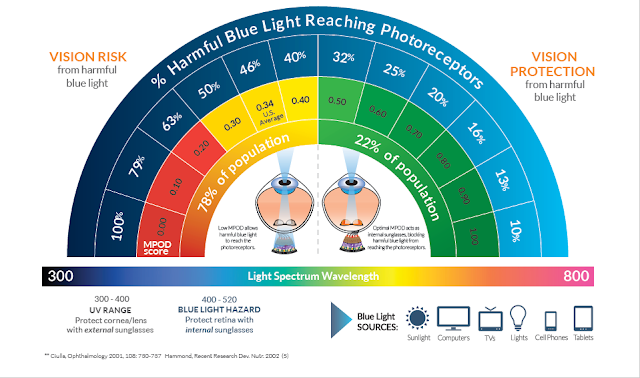Macular Pigment Optical Density - What is MPOD?
What is Macular Pigment Optical Density
The capacity of the macular pigment to retain or channel blue light is estimated as macular pigment optical density (MPOD). MPOD is an optical marker of the centralization of lutein and zeaxanthin in the macula and is turning into an acknowledged biomarker for foreseeing the hazard for illness as well as for visual capacity.
 |
Macular Pigment Optical Density |
In various investigations, MPOD is straightly identified with the levels of lutein in the serum and decidedly corresponded with dietary admission of lutein and zeaxanthin. MPOD estimation is a moderately new innovation, with just a couple of gadgets industrially accessible to assess MPOD; in any case, it has been very much concentrated clinically. More than two dozen investigations have been distributed showing an expansion in macular pigment following lutein or potentially zeaxanthin supplementation at a scope of 2– 30mg every day or a high-carotenoid diet.
The level of increment in MPOD levels following lutein or zeaxanthin supplementation changes, likely because of subject socioeconomics, ailment state, estimation technique, diet, and supplementation regimen.
Macular pigment, likely by means of its blue-light-separating property, has been appeared in various clinical preliminaries to upgrade visual execution—the capacity to see detail and complete visual undertakings. Large amounts of macular pigment add to enhanced visual keenness, glare resilience and recuperation, differentiate affectability, chromatic variation, and photophobia in sound people and also those determined to have agerelated eye diseases.
One examination directed in solid volunteers exhibited a 58% expansion in glare resistance and a five-second decrease in photostress recuperation time following every day supplementation with 10mg FloraGLO Lutein and 2mg OPTISHARP® (DSM IP Resources B.V. Ltd) Zeaxanthin for a half year. Upgrades in these parameters of visual execution can majorly affect ordinary exercises. Glare can show a noteworthy danger to drivers during the evening due to the brilliant light from approaching headlights; the revealed five-second decrease in recuperation time can accordingly essentially enhance evening time driving wellbeing. Glare is additionally a test for competitors and outside aficionados who depend on their vision to enable them to perform taking care of business.
Macular Pigment and Age-related Eye Conditions
Lutein has been related with hazard decrease for age-related macular degeneration (AMD) for over 10 years. This connection began from an epidemiologic examination from the Eye Infection Case Control (EDCC) Study aggregate distributed in 1993, and a subsequent report by Seddon and partners on a subset of ADCC patients distributed in 1994.
 |
| MPOD Map of en Eye |
The outcomes shown that the hazard for creating AMD was 57% lower in people with the most noteworthy lutein and zeaxanthin admission contrasted and those with the lowest.
These epidemiologic investigations give proof that utilization of lutein and zeaxathin from sustenance is related with a diminished hazard for AMD. The National Eye Establishment is right now assessing the movement of AMD following supplementation with FloraGLO Lutein and OPTISHARP Zeaxathin in a vast populace determined to have early AMD, the second Age-related eye sickness think about (AREDS2).
Healthful mediation as enhancements was first assessed by the National Eye Organization in AREDS. AREDS shown that taking an enhancement containing beta-carotene, nutrients C and E, and the minerals zinc and copper decreased the hazard for movement to cutting edge AMD by 29% and diminished visual keenness misfortune by 21%. Lutein and zeaxanthin were excluded in the AREDS contemplate, to a limited extent in light of the fact that amid the arranging phases of the investigation in the mid 1990s, lutein and zeaxanthin were not economically accessible as fixings.
The in-advance follow-up study AREDS2 has included 10mg FloraGLO Lutein and 2mg OPTISHARP Zeaxanthin every day, alone or in blend with 1g of omega-3 unsaturated fats, docosahexaenoic corrosive (DHA) and eicosapentaenoic corrosive (EPA), to the first AREDS supplement definition to survey their impact on movement to cutting edge AMD in people at high hazard for the malady through the span of five years.34 notwithstanding assessing the rate of AMD movement, other all the while assessed results incorporate the impacts of supplementation on psychological capacity, waterfall improvement, cardiovascular infection, vision misfortune, and visual capacity. A subset of subjects will likewise have their MPOD estimated to give facilitate understanding into the connection between MPOD levels and AMD movement.
 |
| MPOD relation eyes |
There is a developing group of proof that, in spite of the fact that not indisputable, underpins that bring down levels of MPOD might be a hazard factor for specific age-related eye conditions. Expanded MPOD may give more noteworthy insurance against oxidative harm, which contributes to a limited extent to the sign of AMD. For instance, hazard factors for AMD including tobacco utilize, light iris shading, propelled age, corpulence, and female sexual orientation are related with low levels of MPOD. Essentially less macular pigment has been found in eyes at high hazard for AMD due to cutting edge malady in the individual eye contrasted and eyes with no known risk.
In an investigation estimating MPOD in AMD eyes and 220 ordinary eyes, the outcomes demonstrated that AMD patients who were not taking lutein supplements had 32% lower MPOD than sound subjects. Strikingly, AMD patients taking high-portion lutein supplements after their underlying AMD conclusion were found to have MPOD levels undefined from those of control patients, in spite of the fact that the investigation did not assess the impacts of supplementation and expanded MPOD on the movement of the disease.
Notwithstanding being available in the macula, lutein is likewise kept in the focal point, yet at much lower concentrations.The way that oxidation of the focal point is a noteworthy reason for waterfalls recommends that cell reinforcement supplements may assume a job in waterfall avoidance. In help of this speculation, high lutein and zeaxanthin consumption from dietary sources has been connected to the decrease in hazard for waterfall extraction in various epidemiologic studies.

